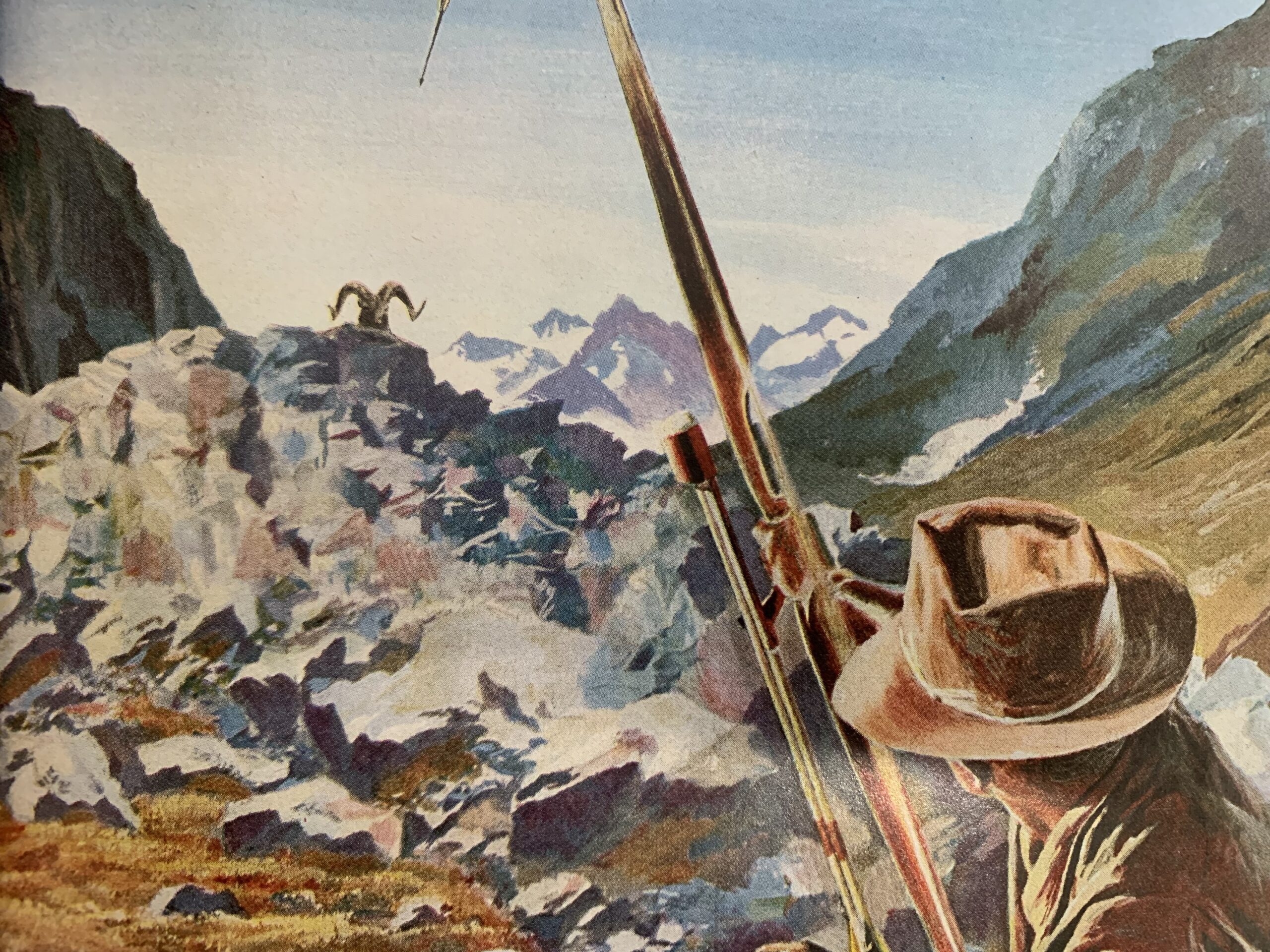It’s easy to forget that many of the people whom we consider legends were indeed just that: people. Iconic stories from the likes of Fred Bear have been told and retold, but much of the pith gets lost over time—and our heroes become more myth than human.
This particular story is one I’d heard many times. I’d even seen a small excerpt in a 100-year anniversary book published by Outdoor Life that I received as a Christmas present when I was a kid. It wasn’t until I picked up the April 1960 issue of Outdoor Life that the story really came to life. The printed words and the sweet smell of aged magazine paper transported me back in time then, and so does rereading it again here.
The story of Fred Bear’s world-record stone sheep is an amazing tale, but it also allows the reader to connect to the humanity of Fred. He was a legendary bowhunter, but he also had worries and doubts like the rest of us. He was also a salesman, who made sure to mention his then-new Bear Razorhead broadheads.
Product mentions aside, Bear still had a code of ethics in a time when such things were often looked at very differently. Some of the shots he took and things he advocated for would have him tarred and feathered by his self-proclaimed followers on the internet today. In fact, the shot that’s the subject of this story was reckless, and based on how he described the wound, Bear was extremely lucky to recover his sheep. He talks about his misgivings about taking that shot, and that he’d had to make a choice—fast. It seems to me that doing so bothered him, even though everything worked out. And that says a lot about the man, and how he became a legend. —Tyler Freel
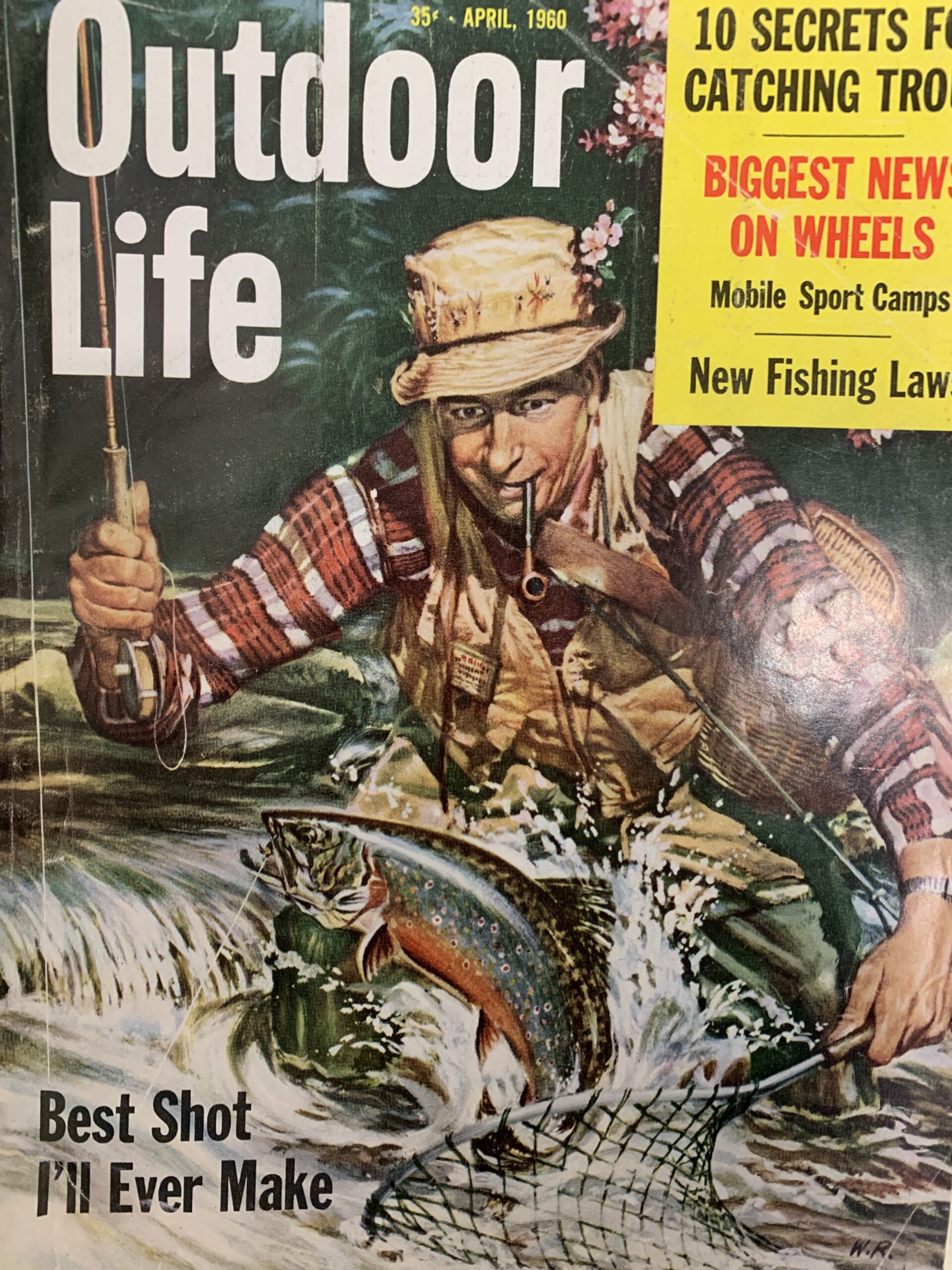
Best Shot I’ll Ever Make
By Fred Bear, as told to Bryon W. Dalrymple
KNICK WAS MAKING his stalk below us, and it looked as if he’d get a goat. I grabbed my camera gear and told my Indian guide, Charles Quock, to stay here on top of the mountain with the horses. Then I hurriedly started picking my way toward the action. When I reached the spot I was aiming for, I couldn’t see Knick, but the goats were in plain sight. The two of them were bedded in a draw far down the steep mountainside, and one appeared to be an excellent trophy. To cover the scene, I set up a tripod for the camera with its telephoto lens.
Now I waited, watching, and presently Knick emerged below me. He was doing a beautiful job. The goats lay placidly dreaming as he stalked closer and closer. They were just below a big rock-a perfect set-up.
Now he was within 35 yards. A gunner might have shot from atop the mountain. But for Knick and the three others of us in our party, getting close to the target was a must. We were all archers. Our party included Elisha (Bud) Gray, a Michigan archer of wide experience and chairman of the board of R.C.A. Whirlpool; Ed Henkel, a bowman of similar experience and one of several owners of Lamina Tool & Die, Detroit, and Kenneth K. Knickerbocker (otherwise known as Knick), who has hunted with a bow for years and is chairman of the board of Acme Visible Records, Crozet, Virginia. I’m in the business of manufacturing archery equipment. To all of us, the stalk to within bow range was at least half the sport.
Suddenly the goats were aware of their peril. As they rose, Knick drew the bow and let fly. It was a beautiful hit, dead center. I forgot to keep track of the other animal, but I saw this one run as I operated the camera. It covered possibly 200 yards. Then it fell, got up again, and disappeared into some buckbrush.
Knick didn’t follow. He came back up and we talked excitedly, rehashing the incident, giving the animal plenty of time. We ate our lunch, and finally we worked down to the thicket. Knick’s trophy was waiting. It had died quickly-a fine specimen with 10-inch horns.
I stood looking at it and thinking what a shake-of-the-dice business hunting is, especially big-game hunting. And particularly, right then, sheep hunting. I’d come several thousand miles after a Stone ram, and I wanted a good one so badly I could fairly smell the chops cooking and see the mounted head on my office wall. We were in an area of northern British Columbia that without question was one of the best spots on the continent for Stone sheep. But, though Charles and I had seen every other imaginable creature from ptarmigan to grizzly and caribou to moose, we hadn’t spotted a sheep. We had not seen so much as a single toothless and rheumatic old ewe. But instead of bemoaning my fate, I should have been remembering the axiom that patience is the hunter’s most valuable asset.
THE STONE RAM, as most hunters know, is one of the truly great trophies among North American game. The horns are unusually long and graceful. In fact, the longest sheep horns ever taken were those of a Stone, and each measured over 50 inches. The Stone sheep is also intriguing because color patterns vary widely among individual animals. They vary so widely, in fact, that for many years there was-and still is in some quarters-much scientific uncertainty about just how many sheep species there are on the continent.
Sportsmen, particularly for purposes of record keeping, recognize four species of North American sheep: 1. Bighorn. 2. Desert. 3. White (or Dall). 4. Stone. Scientists, on the other hand, tend to regard the bighorn and the desert sheep as parts of one super-species, and the Dall and Stone sheep as parts of another super-species. Some scientists even go so far as to lump all North American sheep under one super-species.
Dall sheep are found mainly in Alaska and the Yukon, and the very dark Stones from central British Columbia north into the Yukon. Where the two colors overlap, most of the sheep are varying shades of gray, sometimes with dark saddles. Years ago these “saddle backs” were thought to be a full-fledged species, and were called the Fannin sheep. But now, in this section of the continent, all but the pure white ones are called Stone sheep by sportsmen. I was hoping to get a fairly dark animal, but I was concerned mostly with trying to get a very respectable head. And while I wasn’t dead set on a record, no hunter can help hoping one will come his way.
I had come out from my home at Grayling, Michigan, by United Airlines to Seattle, thence via Canadian Pacific Airline to Vancouver and far on north to Prince George, about 400 miles above the Washington-British Columbia border. The last leg of our journey was a four-hour flight northward from Prince George in a chartered Norseman. Finally our pilot eased us down upon the mirrorlike surface of Coldfish Lake. What a fabulous sweep of wilderness!
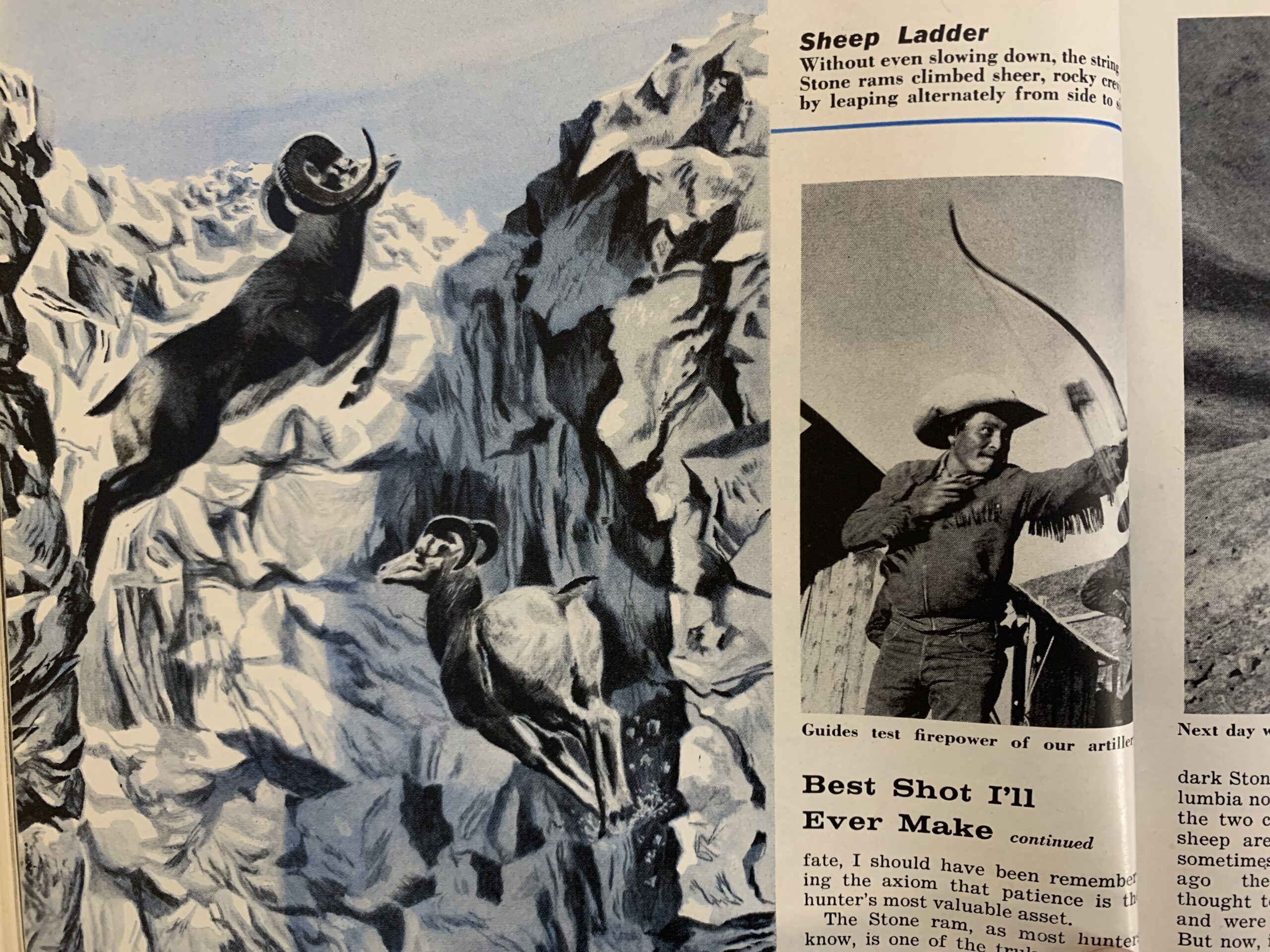
Coldfish Lake is about 150 miles east of Telegraph Creek, which has long been an outfitting area for big game hunting in northern British Columbia. Before there was much flying, the only way to enter the area was out of Telegraph. It took seven or eight days by packtrain, and few hunters got in. Most of those who did were interested in caribou; the region is noted for its big heads.
When the plane taxied to the dock, all of us were pleased to see that base camp was really a solid-looking haven in this far wilderness. By the looks of the crowd on the camp dock, we were having a regular homecoming. Out there to welcome us were Tommy Walker, our outfitter, his partner, Rusty Russell, their wives, and help galore-wranglers and guides, both Indian and white.
On the brink of the hill above the well-built camp was a corral, its fence lined with the wives and children of the Indian men. Behind them was their small “village,” and from back beyond it could be heard the defiant barking of sled dogs. Now that we were down and looking at the surrounding country from the dock, it was even more awe-inspiring than it had been from above. Here were towering peaks as far as we could see. We were only about 200 miles south of the Yukon border, and roughly halfway between the Pacific and the Alberta line.
Every irregularity of the high mountains seemed to be filled by glaciers, and in these were born cascading streams that tumbled down through the spruce and jackpine of the valleys. Here we would hunt in thousands of square miles inhabited only by Stone sheep, goats, grizzlies, moose, and caribou. I could hardly get unpacked fast enough and ready for tomorrow’s start.
Shortly after daylight Ed Henkel, Knick, and I went with Tommy Walker down to the east end of Coldfish Lake to do some fishing. I’d brought tackle along at Tommy’s urging, and I wanted to give it a try before starting the hunt. Otherwise, I knew, I’d likely not take time. It was arranged that we would fish while the pack outfit was made up and got under way. It would pass us later, on the way to our first outpost camp. Saddle horses would be dropped off for us for our trip to camp later.
I unraveled a cast and laid a small dry fly on the calm, frigid water. Instantly there was a swirl, and I was tied to one of the most wild-eyed rainbows I’ve ever seen. It came out in a long leap, fell back, tried again, then bored down and fought stubbornly. It wasn’t large, by wilderness standards. In fact, we found that most of these trout averaged between one and two pounds. But they were beautiful specimens, fat and hard-fleshed, their meat brilliant red and delicious. It was hard to lay down a cast and not get a strike. Time passed quickly, and in my excitement over the fishing I even forgot about sheep. We caught many rainbows, kept all we thought we could eat, and that night the cook heaped our plates with them. I turned in full and content, certain that tomorrow I’d see sheep galore.
Charles Quock and I set off at daylight, riding slowly and glassing the mountainsides carefully. The weather was far from congenial, but right then my spirits were high and it didn’t seem to matter. Presently we spotted a good moose.
“You want this moose?” Charles asked.
I shook my head. “Sheep,” I said, grinning.
Charles grinned, too, and nodded. “Sheep.”
Not long after that we spotted another moose. And later, my horse shied as a small flock of ptarmigan flushed. But stare as I would at the peaks, I could see nothing that remotely resembled a sheep.
During the afternoon it seemed that everywhere we looked there were white patches high on the steep mountainsides. Goats. Charles and I would pause to have a look. I had already taken a goat with my bow on a previous hunt, so I wasn’t anxious to try for another. When Charles looked at me and grinned questioningly after we’d spotted an especially good one, I just shook my head again. I felt this pleased Charles. And I was anxious to please him, for often a bowhunter is a bit handicapped with a wilderness guide. Many of them have never guided archers. Some guides are inclined to take bowhunting as something of a joke, or to be disturbed for fear an arrow can’t do the required job. I had purposely given Charles some instructions about the bow, and I’d let him shoot it to prove what it could do. He was, I felt, an excellent hunter, and I knew he’d hunt all the better if he respected my singleness of purpose and my weapon.
But none of it did any good that day. After many hours in the saddle, Charles and I came in bushed. We had spotted numerous goats, four moose, six caribou—and no sheep. I didn’t want to be discouraged after just one day at it, but I felt that my guide was also a bit disturbed at no sign of sheep. I crawled into my bag that night with a little bit of the buoyancy worn off.
ON THE MORNING of Friday, September 13, I came close to putting sheep in No. 2 place. I was looking absently across to the mountain opposite camp when I realized something was moving there. It was a grizzly, and a beauty. He was a big, black one with much silver up his back, neck, and head, and with black rings around his eyes. If there is one animal that gives me a thrill, it’s the grizzly. The previous year I’d shot a grizzly in the Yukon with my bow, the second one ever taken by an archer. That one had given me a few bad moments (“Arrow for a Grizzly,” Outdoor Life, October 1957) for I had stalked it very close. I was not sure I wanted to crowd my luck too far on this superstition-clouded date. But the more I looked. the more I itched.
“Tommy,” I said to Walker, who was also glassing the bear, “I’ve just got to try him.”
It was 10 a.m. by the time we were ready to leave camp. We rode part way, then left the horses and climbed to a spot well above where we had last seen him. But it was no good. He was nowhere to be seen. We stuck with it until 3:30 p.m. and then gave up and went back to camp. I took a careful look but still couldn’t find him. We ate a bite and I tried again—and there he was, on the next mountain. I got out the spotting scope and began watching him. He was stuffing himself with berries—blueberries, cranberries, mossberries.
After a while, someone set up another scope and said, “There’s a billy goat over this way.” But I kept watching the bear and thinking about all the game we were seeing, yet no sheep. This grizzly was one of several that had tempted me so far. It was ironic. The previous year, in the Yukon. I had set my heart on a grizzly and a goat, and finally got both. On that hunt I was almost always in sight of Dall sheep, yet never took time out to hunt one. And, that time, the grizzly was tough to locate. This year I could see grizzlies and goats all over the place, but no sheep. I began to wonder if possibly I should just hunt each animal as it came along, rather than lose out on everything by singleness of purpose.
Then came the day that I think would have been worth the trip, just because of what we saw. Charles and I rode over a modest range, and suddenly there across a valley were rams—Stone rams. Nine of them!
I was hypnotized by what we were witnessing. I don’t believe I even thought about my bow. We were much too far off for a shot, anyway, and a stalk at this moment would have been impossible. But we were compensated by seeing a sequence that very few persons have ever been privileged to watch.
The rams were hurrying head-to-tail along a shale slide. They were moving up toward a sheer cliff of what appeared to be an insurmountable outcropping of rimrock. We swung down and got our glasses on them and were amazed to see the lead ram, followed by the rest of the band, enter a crevice. In the distant past a glacier-fed stream had cut a vertical slit in the face of the cliff. The slit was about eight feet wide, 60 feet high, and jagged all the way up.
These jagged edges made only the smallest protrusions on each side of the vertical slit. Obviously neither side could be climbed, and I was puzzled about what the sheep would do. They didn’t pause, or even slow down, and suddenly I saw the lead ram bounce from one small foothold on the right side of the slit across and upward. He hit the tiniest outcrop on the opposite side, finding a precarious foothold for only a split second. From an off-balance position, he bounced again, back across and up.
Behind him came the others, bouncing back and forth across the eight-foot-wide cut, up, up, up, until one at a time they topped out on the flat rim above. The great naturalist Seton described this breathtaking ability of mountain sheep. He called such crevices habitually used in this fashion “sheep stairways” or “sheep ladders.” I do not believe any other animal except the goat could have followed those rams.
We examined this area further with a scope, and we discovered a well-beaten trail along the slide to the bottom of the “stairway.” The trail picked up again at the top of the “stairway” and ran along the top of the rimrock to the safety of the peaks beyond. There was no possible way for us to follow. Nonetheless, I somehow had a hunch that this was going to change our luck.
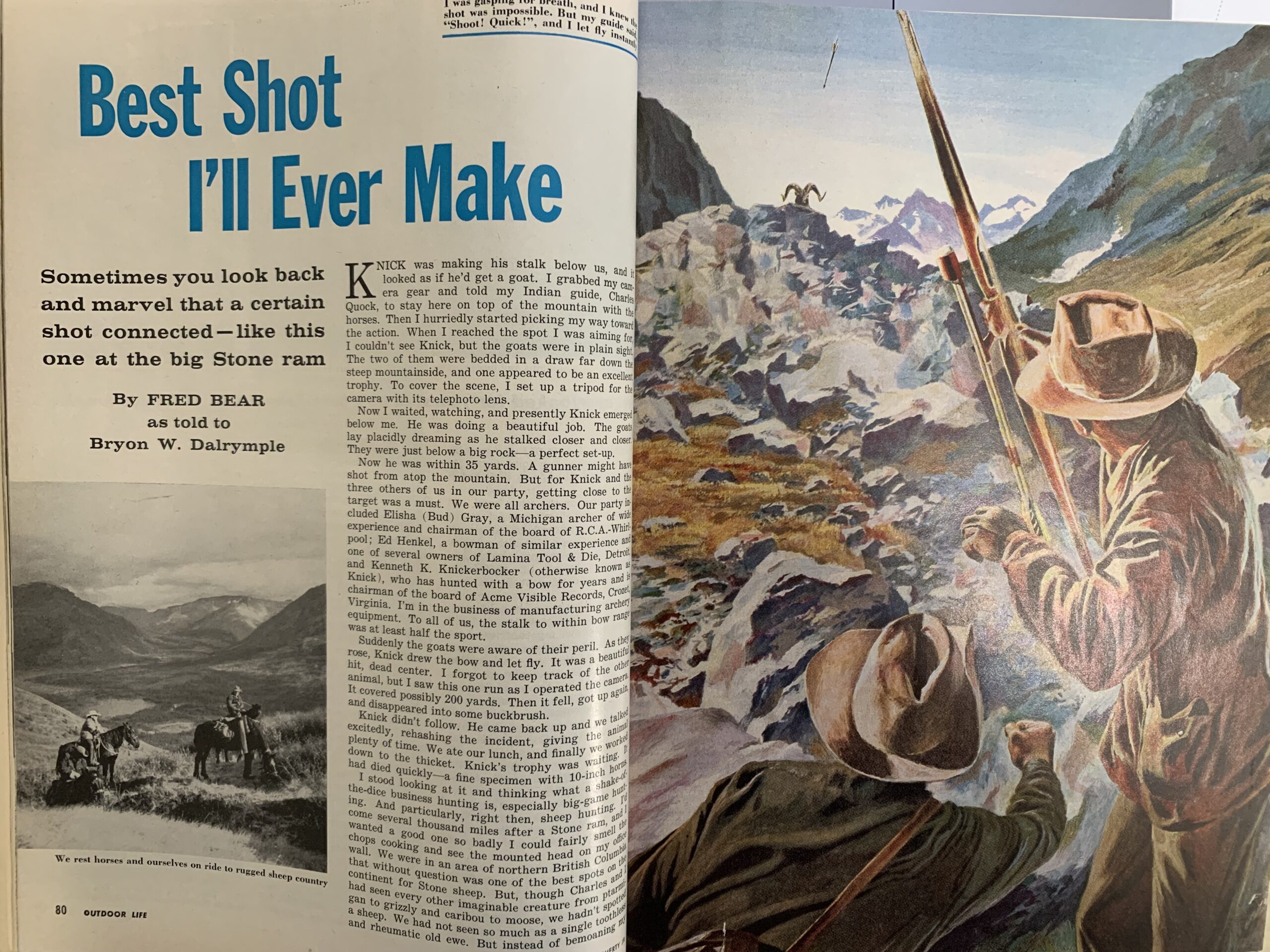
Next day Charles and I rode a long way up a creek, intending to work up into the higher elevations. We saw a moose, and on impulse decided to try for it. All we got for the effort was a lot of lost time. It was now noon. We stopped on another small creek where we’d abandoned the moose chase, and ate our lunch. As we were eating, we saw a white spot on the mountain above. It was a mile away.
“Goat,” I said. But I got out the scope anyway. It was not a goat. It was a rock.
But now something happened that was totally unexpected. As we examined the whitish rock with the sun reflecting from it, we saw something beside it—a Stone ram! What a fluke.
Charles studied it intently through the scope, and there was subdued excitement in his voice when he said, “Full curl.”
Neither of us said another word. We simply forgot lunch and got going.
With utmost care and patience and an agony of hard climbing, we came at last to a spot where we thought we might be in position. The ram had been turned away from us. But now, when we eased our heads over the ridge, he was lying there facing us about 50 yards away. My heart almost stopped. He was a beautiful specimen.
He didn’t take time to study us. He simply bounded up, whirled, and raced away over the shale. I rose and drew as swiftly as I could, and let off the arrow. By then he was at least 60 yards off—a long shot in this game. The arrow never caught up with him, and he disappeared around the mountain.
We took off in hot pursuit, desperately hoping for another chance. The ram must have climbed straight up the rocky peak, for when we next glimpsed him he was at the top, about 400 yards above us, standing and looking our way. I think any rifle hunter can understand how frustrating it is to an archer to get within easy range and then have something like this happen. We continued swiftly along the slant, planning to circle over the top to see if we could find him on the other side.
We were gasping for breath as we came up toward the top of the next ridge. The ram was standing about 40 yards away. He was looking at us; he knew we were after him.
After crossing the shale, we came to a grassy, rolling, steep hillside. Charles was ahead and I was following as swiftly as I could, panting from such vigorous exertion in this altitude. As I loped along, I happened to look back, and was startled to see that we’d passed three more rams in a depression. One was lying down; the other two were feeding, unaware of all this. For a moment I was undecided, but Charles beckoned insistently. The first ram was far larger than any of these.
Just before we reached the top, I glimpsed the big fellow crossing the next draw. I signaled to Charles, who was still ahead. He came back and we watched the ram go over the next ridge. Then we moved over the top and right into a group of seven rams. They scattered like quail. We were as startled as they were, but we had no time for them. Both of us were now doggedly determined to somehow catch up to Mr. Big.
We circled back and peeked over a ridge. With a sick feeling, I saw our ram at a full 150 yards below. just going over yet another ridge. My heart was hammering, and I couldn’t get enough air. For a moment I wondered why a man will punish himself this way. But I also knew I was going to keep following that ram until I either killed it or had to quit from exhaustion.
The successful hunting of both sheep and goats, as most hunters realize, requires a tremendous amount of grueling work. Before previous hunts, I had usually been able to train for several weeks so I could look at a mountain without dread. This time, however, I had flown straight from my office chair, and even after having been here a bit, I still wasn’t in very good shape.
Many people have asked me if bowhunting for sheep doesn’t make the job doubly severe. The longer I hunt and the more experience I gain, the more evident it becomes to me that the species of animal hunted is of little consequence. The big problem is always to come within bow range. Any deviation of tactics or any extra labor comes about because of the terrain, with little emphasis on the type of game.
Sheep of course spend a great deal of time in the roughest of country. The more broken the terrain, obviously, the better chance a hunter has of getting close. Some sheep, because of their location, simply can’t be approached closer than rifle range. Sheep have very good eyes, and take alarm at seeing a man, even from long distances. But patience and work, together with the law of averages, will sometimes present the proper situation.
When you come upon a sheep suddenly at close range, for instance, he is apt to be confused, like the goat, and to just stand and stare in amazement while you shoot.
There’s another important factor that should be considered by the sheep hunter whether he’s an archer or a rifleman. Although a sheep is likely to take off fast when he spots a hunter at a distance, dogged pursuit will sometimes turn the trick. And dogged ours was, as we skidded down over fine shale, then up to the ridge the great prize had disappeared over. Still it was no use—he was then just going over still another rise.
We ran. It seemed crazy, but we hurled ourselves down the slope. Charles knew that sometime, somewhere, that ram was going to pause to look back, to make sure if he’d shaken us. The question was-where? And could I make it that far?
We were gasping for breath as we came up toward the top of the next ridge, and we slowed down. Just as we could barely see across the ridge top, we spotted the ram. He was standing about 40 yards away, and from where we were, we could see only his head. He was looking at us; he knew we were after him.
I never like a head-on shot, for just a few inches either way will only wound the animal. The hole down into the chest cavity at the entrance to the rib cage is no larger than a baseball. Not only that, but if I now made a full draw and shot high enough to clear the ridge, the only place I could hit the ram was in the head, which wasn’t good. Had I been alone, I know I would not have shot. But Charles barked, “Shoot! Quick!”
In that split second, the realization flashed through my mind that if I hesitated—after all this agonizing labor—Charles would be disgusted. I’d lose face with him and probably my hunt would be ruined from there on. There was only one course: I drew the 67-pound bow short, and let fly, trying to lob the arrow over the ridge and drop it below our line of sight into the brisket of the ram.
The shaft with its vicious razorhead—carrying an insert blade at right angles to the main one—left the string and went up and over the ridge. It disappeared in its downward flight, continuing the lobbed arc. All of this sequence, from the moment we’d sighted the ram’s head to the instant the arrow vanished, had taken no more than a second or two. As the head of the sheep disappeared, I got the sick feeling that the arrow had dropped too low after clearing the ridge. That would put it harmlessly between the ram’s forelegs. I knew that a shot of the kind I had tried wasn’t possible.
I was still gasping for breath, and I didn’t want to go to the ridge top to look. But Charles bounded up there, and then I saw him look back with a wide grin.
“Blood,” he said. Red trail ahead, too.” down the other side. “Blood all over.” He waved a hand down the other side.
I forgot I was bushed and winded. I raced up the ridge and looked; Charles was right. Looking down more carefully, we saw the ram. He had run about 60 yards, and had died on his feet. He was jammed against a rock halfway down the shale slide. He had rolled until he hit the rock.
We hurried down to him. What a beautiful animal! He would dress out well over 250 pounds, and his horns were not broomed. They had a 41-inch curl (40 inches after shrinkage), and a 27-inch spread. I was a very lucky fellow to get a ram this big, and would have been happy with a smaller one. It’s believed to be the first Stone ram ever taken by a white man with a bow.
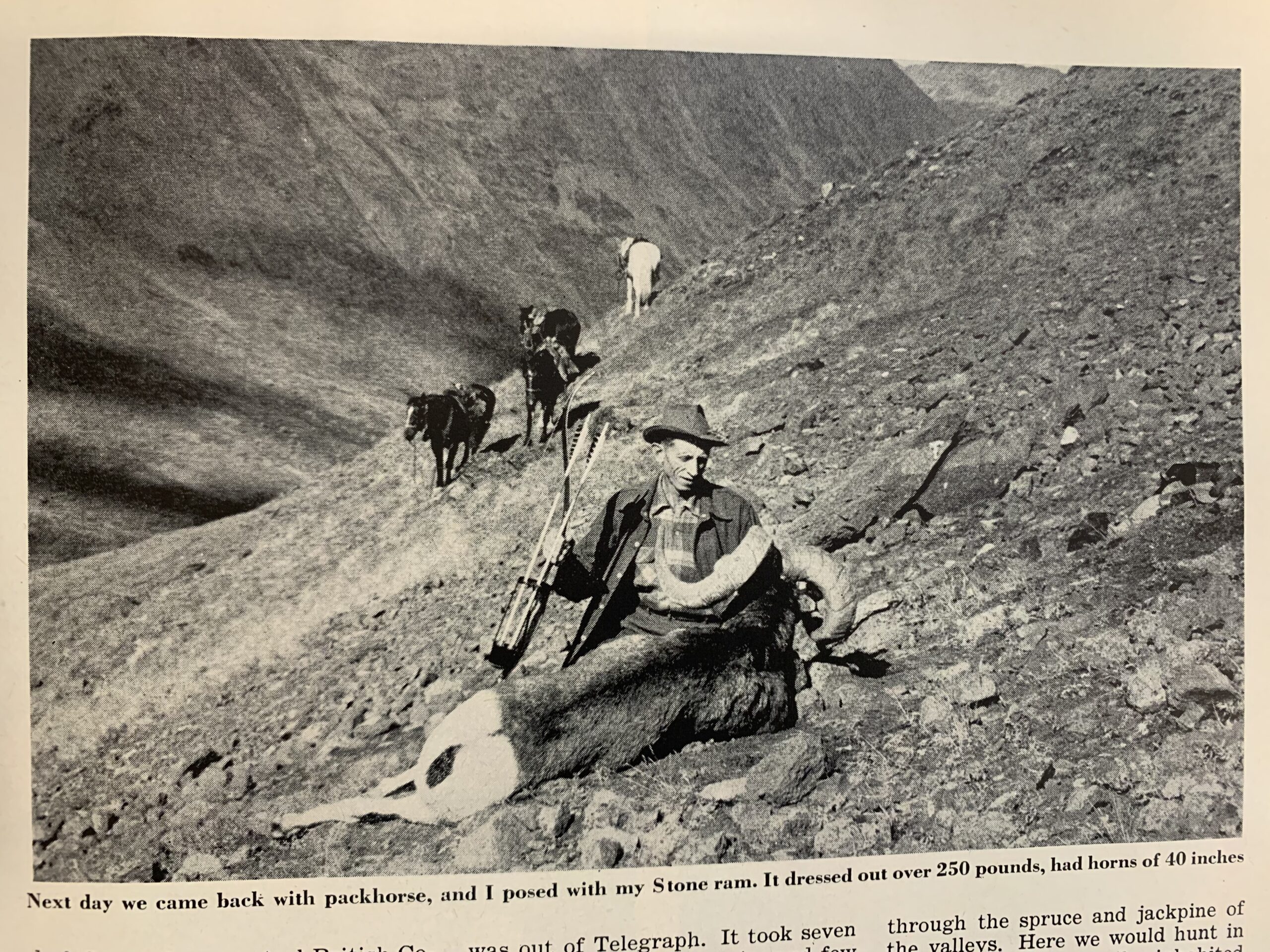
I examined the arrow wound. It was a gaping hole right in the middle of the brisket. I had never seen a more devastating wound. The arrow had cut one or more large neck veins, skidded between the rib cage and the shoulder blade, shed its insert blade, and passed out through a slit behind the front leg. We looked but never did find the 28- inch fiberglass arrow.
Undoubtedly I was lucky in bringing off this shot. But lucky know this was probably the best shot I’ll ever make.
We had left our hats back some distance, with rocks on them to keep them from blowing away. Charles went back after them.
As he left he said, “Roll him down the mountain.”
I was most reluctant. “That’ll break the horns,” I said.
Charles chuckled. “Goat horns brittle, sheep not,” he said.
He left, and I rolled the ram, fearing the worst as it tumbled about 400 yards down the slope and finally came to rest on a bench. Presently Charles returned and we worked our way down. Sure enough, the horns were undamaged. I was greatly relieved. Charles grinned and gave it another nudge. This time it rolled a quarter of a mile, down to where we could get it with the horses.
Charles dressed out the ram, and we took some pictures. It was 4 :30 p.m. and had started raining. We went back to our saddle horses and headed for camp-four hours away. We’d come up next day with a pack animal to take the sheep out.
Next morning, shortly after the sun was up, I looked across from camp and saw a good grizzly on the mountainside. I got the scope and watched him.
Charles came up beside me and said, “You want to hunt grizzly bear?”
“Just want to look, Charles,” I said. “Sheep is enough. I know I’ll never be able to repeat that shot of yesterday.”
